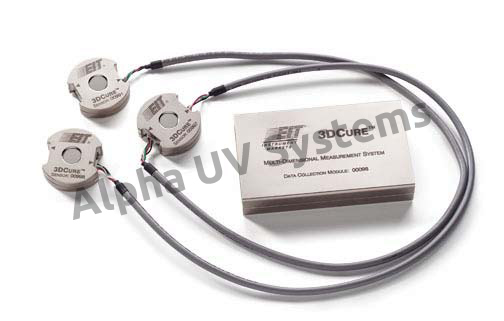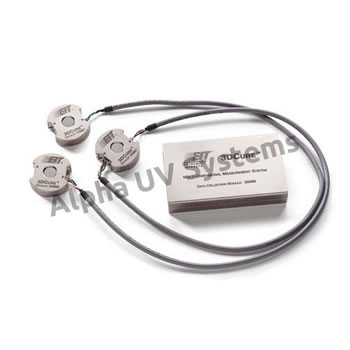Request a Callback

The use of ultraviolet (UV) curing on dimensional and shaped objects continues to grow. UV cured coatings offer several advantages over solvent and/or water-borne coatings processed thermally or with IR. Line design, source placement and/or orientation, documentation of process limits and monitoring production conditions challenge users switching to UV curing technology. The 3DCURE® from EIT addresses these challenges in a simple, flexible and easy to use measurement system. The UV irradiance (W/cm²) and energy density (J/cm²) arriving at multiple points on the cure surface can be easily and simultaneously measured. The 3DCURE® Sensors can be easily mounted or attached at any critical point as needed, therefore avoiding repeated, time-consuming trials with a single radiometer in a single position. 3DCURE® saves your company time and money.
Click on Tabs below for Additional Product Information:
Features
3DCURE® System Features3DCURE® Sensors
Data Collection Module (DCM) / EIT Cure3D™ Software
|
Applications
Matching the number of Sensors to the size of the object allows you to profile objects both large and small. Production lines for dimensional objects vary and can move the object, the UV source or a combination of both. The 3DCURE® System provides functionality for measuring any configuration of the UV system. Measurement challenges that will benefit from the 3DCURE® System include:
|
Operation
3DCURE® OperationEIT’s philosophy of designing durable, easy to use radiometric products continues with the 3DCURE® Multi-Dimensional Measurement System. The Sensors are easy to daisy-chain together. The optic stack is exactly centered under the window so there is no right or wrong way to mount or insert the sensor into the Positioner (see below). When the DCM power switch is turned on, the sensors begin feeding information back to the DCM. Once the desired data has been collected, the DCM is taken out of ‘active’ collection mode and connected to the serial port of a PC via a 9-pin cable. Sensors can remain mounted on a work piece if desired. The DCM’s rechargeable batteries will support measurements up to 60 minutes from a maximum of 32 sensors. Battery condition will be reported when downloading data and the DCM recharges in approximately one hour with the supplied AC charger. For long lasting continuous measurements in tethered mode, the DCM can also operate while connected to the charger. The 3DCURE® Multi-Dimensional Measurement System incorporates up to 32 Sensors, a Data Collection Module (DCM) and EIT Cure3D™ software to collect, transfer and display on a computer the UV that impinges on each serialized sensor. The Cure3D™ software is easy to use and offers two-way communication through the DCM to each Sensor. The digitized data [UV energy density (joules/cm2) and peak irradiance (watts/cm2)] is transferred to a computer and displayed in table format. Because of the wide range of possible applications for the 3DCure®, the included software allows the user to import the information into a spreadsheet program. The software supports ActiveX® to allow further customization and data filtering by end users in a format of their choice. For example, a simple ActiveX® routine can flag any Sensors reporting data below the set threshold or process window. The user can then ping the Sensor through the DCM to illuminate an LED for easy Sensor identification. Adjustments can then be made to bring the UV back into the desired range needed for the process. Measurement Repeatability/PositionerRepeatable, consistent measurements are best obtained by mounting a Positioner on a representative 3D object – example, car fender, piece of furniture, or over an entire car body. The Positioner is round with a flange for screw mounting to the object, and can be mounted at any angle or curvature - these positions do not present a problem. The Sensor is pushed into the Positioner where it is securely held in place. The work object can then be used repetitively as a test fixture or template for any identical object. The Positioners are permanently left in the work piece with the sensors prewired, ready to connect to the DCM. This provides the ultimate in repeatability of measurements, insuring the readings are taken in the exact spot each and every time. Alternatively, the UV sensors can be dropped into the pre-mounted Positioners only when testing needs to be performed; the removal or replacement of a sensor does not introduce variables into the measurement. The Positioners are always mounted in identical positions with no right or wrong way to insert the Sensor. This easily lets the user verify the position and output of the UV source from run to run. The two “flattened” sides of the Sensor allow cables to be connected while the Sensor is mounted in the Positioner. Cable can be fed from one sensor to another through the bottom or top of the Positioner in a daisy-chain configuration that can reach lengths of up to 100’. The open bottom of the mounting adapter allows the user to push the sensor up and out for removal. If, due to mounting constraints, the sensor cannot be pushed out from the bottom, the sensor can be removed by using a special Sensor Extraction Tool that locks onto indentations machined into the sides of the sensor housing. |
Specifications
Sensors (Up to 32 per DCM) | |
| Sensor Size | 1.75” diameter (4.5 cm) by 0.5” H (1.27 cm) |
| Spectral Bandwidths | Single band in any of EIT’s four bandwidths – UVA (320-390nm), UVB (280-320nm), UVC (250-260nm) and UVV (395-445nm) |
| Temperature | Maximum sustained internal temperature of 65°C |
| Dynamic Range Options | Standard Range: 20mW-2W; Low Power: 2mW-200mW; High Power: 200mW-20W |
| Spatial Response | Cosine |
Data Collection Module (DCM) | |
| Data Resolution | 1 part in 10,000, with standard range set at 2W |
| Sensor Support | Each DCM supports 1-32 sensors. Sensors of different bandwidths can be mixed on the same DCM in the same string |
| Battery | Rechargeable NiMH. Will support up to one hour of data collection with 32 Sensors. One hour recharge. Can operate on continuous A/C power |
| All 3DCURE® Systems include: Computer Interface Module (CIM), Cables, Charger, Sensor Extraction Tool, Positioners, User Manual and Carrying Case | |
| Note: Specifications are subject to change. | |
Search in Shop
Recently viewed:
-
EIT 3DCURE
Notice: Undefined property: stdClass::$prices in /home/alphauvc/public_html/templates/rt_nuance/html/mod_virtuemart_product/default.php on line 115
Call for price
Notice: Undefined property: stdClass::$prices in /home/alphauvc/public_html/templates/rt_nuance/html/mod_virtuemart_product/default.php on line 83



